Chapter 15. Asteroids: Composition and Collisions
15.1 Introduction

Author: Kristen Miller
Editor: Grace L. Deming, University of Maryland

The goals of this module: After completing this exercise, you should be able to:
- Describe the main characteristics of the asteroid belt.
- Describe the composition of an asteroid.
- Explain how collisions help us understand the interior structure of asteroids.
- Estimate the likelihood that an asteroid of a certain size will collide with the Earth.
In this module you will explore:
- How the Trojan asteroids maintain a stable orbital balance with Jupiter.
- How loosely packed the asteroid belt really is.
- The devastating effects an asteroid-Earth collision can have on both the environment and life.
Why you are doing it: Studying the Trojan asteroids and the asteroids in the belt help us understand both the conditions that prevailed in the early solar system and the events that occurred as the planets formed. Asteroids are also important to study because we know that some pass near the Earth, many have collided with the Earth in the past, and surely will again in the future. Asteroids therefore affect our lives in a very direct and personal way.
15.2 Background
When we look at the spacing of the planets in our solar system, a pattern emerges: as we move outward, we find that each planet is located roughly twice as far from the Sun as the previous planet. The Titius-Bode Law formalized this pattern, stating that the orbital semi-major axis of each successive planet increases by a factor of 1.4-2.0. While it is only a rule of thumb and not a fundamental law, the Titius-Bode Law was a useful concept for scientists in the late 18thcentury. However, there was one glaring exception to this rule: Jupiter! Jupiter's orbit is more than 3 times farther from the Sun than Mars'. The dilemma could only be resolved if there was an as yet undiscovered planet between the orbits of Mars and Jupiter, a fact which spawned a world wide search for a new planet.
The result of that search was the discovery of the asteroid 1 Ceres (asteroids are given a number in order of discovery and also a formal name) and, ultimately, the discovery of hundreds of thousands of asteroids all orbiting the Sun between the orbits of Mars and Jupiter. We shall see in this activity that these asteroids, even if combined into one large object, are not enough to account for the missing planet. However, they are interesting objects, worthy of study in their own right, and have impacted the evolution of life on Earth in very dramatic ways!

Question 15.1
v7gpMF1/cDvWFplSaa2mIlmCATXUHN4gLwZPnC80f8JQn60t2dN3hUwb4VEN+HK3w7eKoLQ4OZWHPxL6IwWx/uLfA64KOivc9Mgl7y5N4MbQuENnMveulqcxDSlBVXXgW1iXxpPxYQ+E3RCvdcLEEzijNyaxepIQqptdGkMu9CiZtMC/dB3ByQ==15.3 Basics of the Belt
The majority of the asteroids are located in a belt between 2 and 3.5 AU, right between the orbits of Mars and Jupiter. The major exception is the group of Trojan asteroids, which revolve around the Sun on the same orbital path as Jupiter. These will be discussed a little later.
There are more than 300,000 known asteroids in the asteroid belt, and thousands more are discovered each month! Most asteroids are between 50 - 1000 m in diameter. Added together, all of the asteroids in the asteroid belt would be barely enough to make an object 1500 km in diameter. That is much smaller than any planet in the solar System - in fact, it is less than half the size of our Moon, which has a diameter of 3476 km. This suggests that the asteroids are remnants of a planetesimal or a protoplanet from the early solar system and not the shattered remains of a "missing" planet between Mars and Jupiter!
Even though it has so many inhabitants, the asteroid belt is still mostly empty space - in other words, its density is still very low. We can understand this better by making a scale model of the asteroid belt. Suppose we use a basketball to represent an asteroid. (Keep in mind that most asteroids aren't spherical like a basketball; however, using a circular object will simplify our calculation.)

If the basketball to the right represents a typical asteroid in the belt, how far away would its nearest neighbor (in any direction) be located?
A basketball is about 12 inches, or about 30.5 cm. If this is a typical 1 km asteroid, then our scale is 1 km = 30.5 cm. The area of the asteroid belt is given by π·(R2 - r2), where R and r are the outer and inner radii. So, the area is π·(3.52 - 22) = 26 AU2. If we divide the total area by the total number of asteroids (300,000), then we find each asteroid has an area of 0.000086 AU2. This area corresponds to a circle with a radius of 0.005 AU, or 784,498 km. An asteroid's nearest neighbor is twice this radius away, or roughly 1.5 million km away.
Question 15.2
Msx2ZPdNe9/VP0p3WaEMe16HPqsOzpy/vLIlvjhE1Cr5sFveYpOcXIk2C50MUbZj1vxYCLjtrnpxaSFXm6C9gKIHsJ+D9vBn9AdrwJ8+oDfePT20YztvUyNWt4FSIX1j6025jApgtY3AmFOIMC+gOgJ6H2MB5L43E3NedeGsJrpewU+8S4Igwf7MWe2Jl/fSIk4rKpSb5oUJ0VJYQN+bLXZl+q2jAOrE/Dbumhp0Q6b/bJLQsZlIyMySQEzK8/yrHmA2w5IUgZ5wkK09icobVAXWCV/dUKXLriWsE+LUxduAxGkI9ECmyTIlOkqBKWf3Spen4JGqJCQ4Y8lYnjTJ7ZAfXjICUKEQ8UzIgUGpSz2tM6d5xtGjhbjnurq3t7tFCLDK5MATg9QiE5YCaH7ODF6r/UZ7a1sO3ulaFQ6OwLkOr025V5rhXg+LR9KnaHoxAk/refDR/Ww=15.4 The Trojan Asteroids
There are two groups of Trojan asteroids, one that is always one sixth of the orbital path ahead of Jupiter and one that is always one sixth of the orbit behind. These two points are stable positions called Lagrange points. These Lagrange points are simply locations on Jupiter's orbital path where the combined gravity of the Sun and Jupiter trap objects. This means that if an asteroid starts to move away from the Lagrange point in any direction, gravity pushes it back. The Trojan asteroids were probably captured during the early stages of formation of the solar system and are now held indefinitely in a stable, delicate gravitational balance.
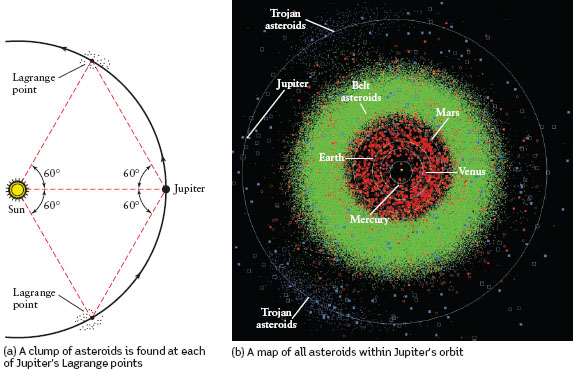
Question Sequence
Question 15.3
aPBcQDOZ3mwXsPvZ2h0+mjZ39M3c2f+ccp/9E74B5Pixen0t9pdrDsEkIkxG03q17GKw1Me6b43oRguT4KeTnYFFvrnswgq8Z8x+J5XMj79ppQtCXWcsJXx2RGkZcvomav2fOl8WTSblHvxUg+zBXXj98lc=Question 15.4
1GqqnhfoDdAkIXchvFv9mlRb+VUigBgYNYzGf7DBKcblgLIe+xDQmquKr7bYsVoV2UcVI9B+B0GJPRfSp0aAX9t8MYswacyk/dwKcHF3ahInWISn68PkyE4X32uSjTMSNZprdaTGP2xjcXp3+rZXWqjpHakSnBMfEgM6/Sg1ZsVA5Qz8KExPn6TncEfqqgSS+cFueA8JvXyMmD8cxa6Qi2sX2sgCfnoF8fz4N+fJGW6CvGVR+5FAZIuol3EzaCKy8GYsMcX+ugi4vIumeL5K3ZbXmdr5zFmBUU66JYmzENW8csfE8+Sn/bu15CLBSJJ4L0+LEb6l/hu9ooWVULyV2xeCq8Ti5VFN0AeAY2Mjx7XRnRa6ixMY94XapBN9UcCQJZPziO8OoBOodM/lhaUQ4w==15.5 Asteroid Compositions
Asteroids are composed of rocky material. They are divided into two main groups: carbonaceous asteroids are those with significant amounts of organic material and silicate asteroids are those which are primarily rocky; this makes the latter much more reflective of sunlight than the former. The vast majority are irregularly shaped, often resembling a potato. Only a handful of the very largest (most notably Ceres) have enough self-gravity to be spherically shaped.
Most asteroids - at least those larger than 1 km - are not solid rocks but are associations of rocky pieces held together by gravity. Because of this, they are often described as "porous" or "rubble piles". Their porous nature explains how their densities can be lower than the materials they are made of (rock). It also likely explains how they can survive impacts that are violent enough to leave behind the large craters we observe. This is shown in the animation below:
Question Sequence
Question 15.5
Jdd/MkE8/MGx4pUUm8W4I3G5ZtvRCFob0Q/BKbBILK6l9GG2GsghxpeJaT2M7jM1FBtNJGpJWAGuJ8u8mK3e19wlVoZN/kGjZVvWKeBGtd9PEvP4IpO9zYmptgx4ZmQqfX9Am6uh4xKahGIneEJOYm/WmwVUdOe2TO9xQ0j2AvCSrA51yzs0JmNeXtByZueIFn3mA+jmy7ISqo9VCAqOXLyWSTwE0gyeAu4AM1gQRkqikV5r6SVUCvSkfBCriUFkLQmR64BlZ3W1kj4ie/OEeA+HcmmTQRYONkJu6dFlohtohQ9cYSQXKKuRMMaK3FNQLUTwXN/CfzqIeF3ay1LyHK4Y7ThfjgwhtsZS9n+UGdzgjoCpCRKP0+SWg9XZxwZZxsNpl9LbGrBBbU/b/9nDH+XNtwjfuvxueO4yVfllm/TLHwnFOctNw3NFxuU26v1+rXuygzpMJ/AHsvgUZvxOmQEvR9kfwIZUQleKZ/RZfSE3EMja+W2ewesWTCILBaybI1rxmKqj32VCM132dORgK+emvwaLGnN1f93QdIYwrlOTNG8G8yJIhigE2MKd6N8GmY/QoMGLLeZ4JY1DnbKemq6l1JEXH4UvySKrdqUe528=Question 15.6
vKwevPKHgRyV/+rbh8h8fuUyt5Mq0hNN7/QtXcbB4wK1s23q4R7h0nW0brhYD9Nz4hUFuzxQC6I6jig5r08yV91Xnv/yNjLHIgjbJmRP+vi6FwCRpAVURwggH9gF4PvKJpurRIduWV6F3XbMR0jBsWgvNFK+yepDDK71G9gWE+TNCmmHAMDAaZAxbgitxTREYz412N8Lvyyg6IpUjf72P0qp4JM=15.6 Asteroid-Asteroid Collisions
The surfaces of asteroids are highly cratered due to frequent collisions in the asteroid belt. Typical collisions occur at speeds of 1-5 kilometers per second , which is fast enough to shatter rock. As discussed on the previous page, such collisions do not necessarily shatter the entire asteroid due to its porous nature. Instead, they result in craters (often large craters which can be a significant fraction of the size of the asteroid itself) on the surface of the asteroid, creating a rocky, uneven terrain. The Galileo probe observed the asteroid Gaspra in 1991; the following video shows the data Galileo sent back. Note Gaspra's irregular shape and heavily cratered terrain. Watch the video.
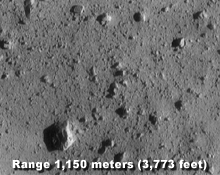
In February 2001, the NEAR (near earth asteroid rendezvous) Shoemaker spacecraft actually landed on an asteroid (Asteroid Eros). What the spacecraft saw during its final descent is shown in the animation on the right.
Question Sequence
Question 15.7
0NJVYpEc07f281xtGRF971398cU8Holjl7kCgaifEDQqBCqa1Z82EWcwMFNK/vOhRdJdYFQrpV3HwfQ5SamR77daSHg2xAn/2XmZe1HMsDoExBdjmCsG/4de0ZCw238UDWkBgBbw+fAI4ddMzRQQk35/p4HpXIZMG9BW2DlDF01kVsrZcUeWsye9HxGPKB4va12V9asLfXqPNUbfnGjrMA==Question 15.8
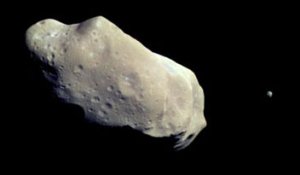
Asteroid-asteroid collisions not only alter the shape of the asteroids involved, but they are also believed to be responsible for the formation of asteroid satellites. The satellites of asteroids may be pieces of one of the colliding asteroids that broke off during the collision and were subsequently captured.
lIQr/yotzYsge876Lu729yeUV6JNurlNPJXq/Nk8jkYr1RLfAXVuxwhto+x/EjkBcByKELsG+AMDm4azUlhL//YvpbqzvxRgG9WpTX/wrD0wswCHV9EOnDbWQ9UEt1AH0dMBW6ek5pOcXkRG120LamnlMJY6e18BfsEt1uXzDFt8eo9smyjPz7Cg9fE=15.7 Asteroid-Planet Collisions

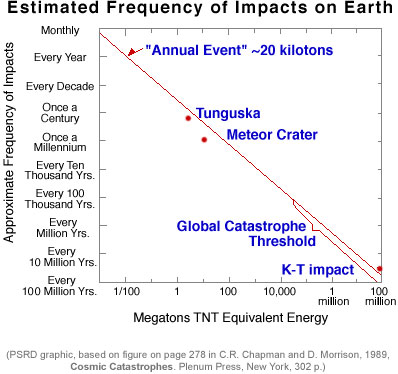
Collisions are not limited to the asteroid belt, however. There are many asteroids which travel outside of the belt on orbits with a wide range of eccentricities and inclinations. Their orbits are most likely the result of gravitational interactions with very large planetesimals during the formation period of the solar system. Many of these asteroids regularly cross the orbits of the inner planets (including Earth!) and travel very close to the Sun. We do not know precisely how many asteroids fall within this group, but we do know that the possibility of a collision is very real, as shown in the figure to the right.
This graph shows how often an explosion of a certain magnitude occurs due to a collision with an asteroid. A 1 km asteroid corresponds to 500,000 megatons of energy and, according to the graph, occurs roughly every 300,000 years.
Question 15.9
Hv6WGxDyRSdBCfX2rUqN4wU/vmk71xanGpNFNYH3n2mnalLfJlncKiRjYe+1KZJjqfgRGffY25ImaYuuTmeBguTFFvWEObDXrAE7UwIx4PQinIDQ/iCy4MbAjOl+7l9Zo++NUFjeYo0euDKER11UfcPFU1dY6rXwGUkraTLeEhcXdgLjcWN2YSBgvN/Y+/CDzkMp3ut2tXfORqcqCoSexk9uUpcOJAXGsOxVj4qZ+QPYYHPzE0e3NlvbQmTvu7mdk6cZRKvgU7BXIu6zMI4hmA/Uq/j2eNRueBZGil7I/isWOMbGIQW5AQ==15.8 Asteroid-Planet Collisions (continued)
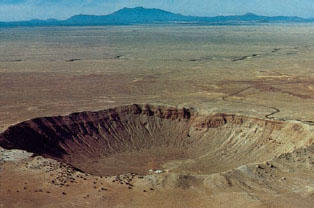
Given that the Solar System is several billion years old, it should be no surprise that there is ample evidence that collisions have occurred on the inner planets, including the Earth. The first two figures show:
- Meteor Crater in Arizona, which was created about 50,000 years ago by a 50 m iron asteroid and
- the Tunguska event, in which an 80 m stony asteroid exploded in the atmosphere.
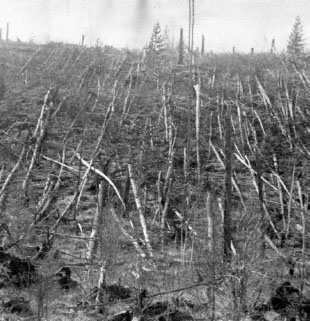
Geologists have discovered a worldwide layer of iridium rich clay that was deposited about 65 million years ago. Because iridium is common in iron-rich asteroids but rare in the Earth's crust, this layer indicates a period in the Earth's history when large amounts of asteroidal dust was deposited on Earth. The real significance of this layer of iridium is that it appears precisely when the dinosaurs suddenly became extinct, suggesting that the extinction may have been the result of a large asteroid collision and the environmental crisis that followed. This collision is referred to as the K-T impact. The Chicxulub Crater, shown below, in Mexico is roughly 65 million years old and appears to have been the result of a collision with a 10 km asteroid. Many scientists believe that this collision led to the extinction of approximately 70% of species living on Earth at the time, including the dinosaurs, and to the iridium-rich clay layer, as shown in the following animation.


Question 15.10
EoLhsk2oT2zA4A7Y55zwvYVuj+tj4gFTFEpFGEv+33jGIUvfTR5W/hsZv/xSC7YIHwuNGwCCyzLoRoTWywaLybPDaCEJjlLoJfFZIoiNjHACCnkajLn5eg5+dTFD63wzzxPHrTCK5Y0Q3tdJ9VpIGmwyNVjrsj1H58rmMlEQbnQnEUKtuudAzUaPFhkEKFAgap0hxD4iB38uQPacrWe4qPo1wvpluKVCKerDKvQwmGPP2aabUhcQY58ZFAxoX9DNxxWi/IpbEnnANWMpUD5WL5Niq28hF6+6kaIK1pE9HKKP/vw/avvtC6w2F4503K/+JKbLNKUZHlDGLouUPW8XJ9e2qFFTIgPJhTU71AK7uDo5Mazs15.9 Quick Check Quiz
Indepth Activity: Asteroids: Composition and Collisions